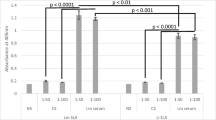Abstract
Highly susceptible naive BALB/c mice or mice that had previously been immunized i.v. with solubilized homologous antigen (partially resistant) were infected withLeishmania amazonensis. Histologically, the main differences between the two groups were lymphocytic infiltration and macrophage activation. Assays of T-cell function at 3 and 10 weeks after infection revealed that purified T-cells did not proliferate following treatment with leishmania antigen. A mitogenic anti-CD3 monoclonal antibody (mAb) failed to activate T-cells after 3 weeks of infection as judged by proliferation and IL-2 secretion assays. After 10 weeks of infection, anti-CD3 mAb fully activated T-cells to proliferation and IL-2 secretion. On the other hand, T-cells released IL-3 in response to leishmania antigen, anti-CD3 mAb and anti-Thy1 mAb at 3 and 10 weeks post-infection. Surprisingly, a mitogenic anti-Thy 1 mAb (G7) fully activated T-cells even at 3 weeks of infection as judged by proliferative and IL-2 secretion assays. No significant differences were found in the proliferative or interleukin secretory responses of T-cells from animals that had been infected in either the presence or the absence of prior immunization. Since the Thy1 triggering pathway has different accessory cell and cytokine requirements than does the CD3: TCR lymphocytes activation pathway, it is possible that immunization was more effective in changing the cellular interactions of the T-lymphocyte than in altering its intrinsic capabilities.
Similar content being viewed by others
References
Adams DO (1976) The granulomatous inflammatory response. A review. Am J Pathol 84:164–178
Adams DO, Hamilton TA (1984) The biology of macrophage activation. Annu Rev Immunol 2:283–318
Alcover A, Ramarli D, Richardson NE, Chang HC, Reinherz E (1987) Functional and molecular aspects of human T lymphocyte activation via T3-Ti and T11 pathways. Immunol Rev 95:5–36
Barral-Netto M, Reed SG, Sadigursky M, Sonnenfeld G (1987) Specific immunization with solubilized antigen in experimental American cutaneous leish maniasis. Clin Exp Immunol 67:11–19
Behin R, Mauel J, Sordat B (1979)Leishmania tropica: pathogenicity and in vitro macrophage function in strains of inbred mice. Exp Parasitol 48:81–91
Black MM, Epstein WL (1974) Formation of multinucleated giant cells in organized epitheloid cell granulomas. Am J Pathol 74:263–276
Crawford CL, Hardwicke PMD (1978) Ultrastructural features of epitheloid cell granuloma induced by intradermal injection of xenogeic nerve tissue. J Pathol 125:107–115
Feng ZY, Louis J, Kindler VT, Pedrazzini T, Eliason JF, Behin R, Vassalli P (1988) Aggravation of experimental cutaneous leishmaniasis in mice by administration of interleukin 3. Eur J Immunol 18:1245–1251
Gunter KC, Malek TR, Shevach EM (1984) T cell activating proerties of an anti-Thy 1 monoclonal antibody: possible analogy to OKT3/Leu4. J Exp Med 159:716–730
Gunter KC, Germain RN, Kroczeck RA, Saiton T, Yokoyama WM, Chan C, Weiss A, Shevach EM (1987) Thy 1-mediated T cell activation requires co-expression of CD3/Ti complex Nature 326:505–507
Hamann A, Thiele H-G (1989) Molecules and regulation in lymphocyte migration. Immunol Rev 108:18–44
Heinzel FP, Sadick MD, Holaday BJ, Coffinan RL, Locksley RM (1989) Reciprocal expression of interferon gamma or interleukin-4 during the resolution of progression of murine leishmaniasis. Evidence for expansion of distinct helper T cell subsets. J Exp Med 169:59–72
Howard JG, Hale C, Liew FY (1980) Immunological regulation of experimental cutaneous leishmaniasis: III. The nature and significance of specific suppression of cell-mediated immunity. J Exp Med 152:594–607
Jenkins MK, Pardoll DM, Mizuguchi J, Quill H, Schwartz RH (1987) T cell unresponsiveness in vivo and in vitro: fine specificity of induction and molecular characterization of the unresponsive state. Immunol Rev 95:113–135
Julius MH, Simpson E, Herzenberg LA (1973) A rapid method for the isolation of functional thymus-derived murine lymphocytes. Eur J Immunol 3:645–649
Kroczek RA, Gunter KC, Seligman B, Shevach EM (1986) Induction of T cell activation by monoclonal anti-Thy 1 antibodies. J Immunol 136:4379–4384
Lelchuk R, Gravely R, Liew FY (1988) Susceptibility to murine cutaneous leishmaniasis correlates with the capacity to generate interleukin 3 in response to leishmania antigen in vitro. Cell Immunol 111:66–76
Leo O, Foo M, Sachs DH, Samelson LE, Bluestone JA (1987) Identification of a monoclonal antibody specific for a murine T3 polypeptide. Proc Natl Acad Sci USA 84:1374–1378
Mayrink W, Williams P, Costa CA, Magalhaes PA, Melo MN, Dias M, Lima AO, Michalick MSM, Carvalho BF, Sessa PA, Barros GC, Alencar JTA (1985) An experimental vaccine against American dermal leishmaniasis: experience in the State of Espirito Santo. Ann Trop Med Parasitol 79:259–269
McElrath MJ, Kaplan G, Nusrat A, Cohn ZA (1987) Cutaneous leishmaniasis. The defect in T cell influx in BALB/c mice. J Exp Med 165:546–559
Mossmann TR, Coffman RL (1989) Heterogeneity of cytokine secretion patterns and functions of helper T cells. Adv Immunol 46:111–147
Pabst R, Binns RM (1989) Heterogeneity of lymphocyte homing physiology: several mechanisms operate in the control of migration to lymphoid and non-lymphoid organs in vivo. Immunol Rev 108:83–109
Papadimitriou JM, Spector WG (1971) The origin, properties and fate of epithelioid cells. J Pathol 105:187–203
Picker LJ, Kishimoto TK, Smith CW, Warnock RA, Butcher EC (1991) ELAM-1 is an adhesion molecule for skin-homing T cells. Nature 349:796–799
Quill H, Schwartz RH (1987) Stimulation of normal inducer T cell clones with antigen presented by purfied Ia molecules in planar liquid membranes: specific induction of a long-lived state of proliferative nonresponsiveness. J Immunol 138:3704–3712
Scott P, Natovitz P, Coffman RL, Pearce E, Sher A (1988) Immunoregulation of cutaneous leishmaniasis. T cell lines that transfer protective immunity or exacerbation belong to different T helper subsets and respond to distinct parasite antigens. J Exp Med 168:1675–1684
Turk JL, Jones B, Parker D (1978) Ultrastructural observations of epithelioid cell granulomas induced by zirconium in the guinea pig. J Pathol 124:45–49
Van der Rhee HJ, Van de-Burgh W, Deams WTh (1979) The differentiation of monocytes into macrophages, epithelioid cells, and multinucleated giant cells in the subcutaneous granulomas. Cell Tissue Res 197:355–363
Author information
Authors and Affiliations
Rights and permissions
About this article
Cite this article
Pompeu, M., Freitas, A.L., dosReis, G.A. et al. T-lymphocytes in experimentalLeishmania amazonensis infection: comparison between immunized and naive BALB/c mice. Parasitol Res 78, 16–22 (1992). https://doi.org/10.1007/BF00936175
Accepted:
Issue Date:
DOI: https://doi.org/10.1007/BF00936175




